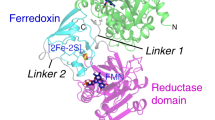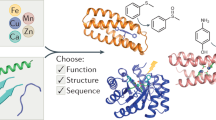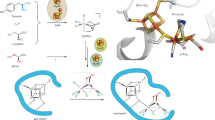Abstract
Here we report the de novo design and NMR structure of a four-helical bundle di-iron protein with phenol oxidase activity. The introduction of the cofactor-binding and phenol-binding sites required the incorporation of residues that were detrimental to the free energy of folding of the protein. Sufficient stability was, however, obtained by optimizing the sequence of a loop distant from the active site.
This is a preview of subscription content, access via your institution
Access options
Subscribe to this journal
Receive 12 print issues and online access
$259.00 per year
only $21.58 per issue
Buy this article
- Purchase on Springer Link
- Instant access to full article PDF
Prices may be subject to local taxes which are calculated during checkout


Similar content being viewed by others
Accession codes
References
Bolon, D.N., Voigt, C.A. & Mayo, S.L. Curr. Opin. Chem. Biol. 6, 125–129 (2002).
Koder, R.L. & Dutton, P.L. Dalton Trans. 3045–3051 (2006).
Lu, Y., Berry, S.M. & Pfister, T.D. Chem. Rev. 101, 3047–3080 (2001).
Bolon, D.N. & Mayo, S.L. Proc. Natl. Acad. Sci. USA 98, 14274–14279 (2001).
Jiang, L. et al. Science 319, 1387–1391 (2008).
Röthlisberger, D. et al. Nature 453, 190–195 (2008).
Bryson, J.W. et al. Science 270, 935–941 (1995).
DeGrado, W.F., Summa, C.M., Pavone, V., Nastri, F. & Lombardi, A. Annu. Rev. Biochem. 68, 779–819 (1999).
Razkin, J., Lindgren, J., Nilsson, H. & Baltzer, L. ChemBioChem 9, 1975–1984 (2008).
Johnsson, K., Allemann, R.K., Widmer, H. & Benner, S.A. Rere. Nature 365, 530–532 (1993).
Maglio, O. et al. C. R. Chimie 10, 703–720 (2007).
Lombardi, A. et al. Proc. Natl. Acad. Sci. USA 97, 6298–6305 (2000).
Maglio, O., Nastri, F., Pavone, V., Lombardi, A. & DeGrado, W.F. Proc. Natl. Acad. Sci. USA 100, 3772–3777 (2003).
Bell, C.B. III et al. Biochemistry 48, 59–73 (2009).
Calhoun, J.R. et al. J. Am. Chem. Soc. 130, 9188–9189 (2008).
Berthold, D.A., Andersson, M.E. & Nordlund, P. Biochim. Biophys. Acta 1460, 241–254 (2000).
Berthold, D.A. & Stenmark, P. Annu. Rev. Plant Biol. 54, 497–517 (2003).
Summa, C.M., Rosenblatt, M.M., Hong, J.K., Lear, J.D. & DeGrado, W.F. J. Mol. Biol. 321, 923–938 (2002).
Kaplan, J. & DeGrado, W.F. Proc. Natl. Acad. Sci. USA 101, 11566–11570 (2004).
Maglio, O. et al. J. Biol. Inorg. Chem. 10, 539–549 (2005).
Lahr, S.J. et al. J. Mol. Biol. 346, 1441–1454 (2005).
Vincent, J.B., Olivier-Lilley, G.L. & Averill, B.A. Chem. Rev. 90, 1447–1467 (1990).
Koval, I.A., Gamez, P., Belle, C., Selmeczi, K. & Reedijk, J. Chem. Soc. Rev. 35, 814–840 (2006).
Corbett, J.F. & Gamson, E.P. J. Chem. Soc. Perkin 2, 1531–1537 (1972).
DeGrado, W.F. et al. Angew. Chem. Int. Ed. 42, 417–420 (2003).
Acknowledgements
The authors thank M. Trifuoggi for metal content analysis. This work was supported by the Italian Ministry of University and Scientific Research (PRIN 2007KAWXCL), the European Commission (Marie Curie Fellowship HPMD-GH-01-00113-03 to R.T.M.R.), the US National Institutes of Health (GM54616) and the US National Science Foundation (grant from the Materials Research Science and Engineering Center to the Laboratory for Research on the Structure of Matter at the University of Pennsylvania).
Author information
Authors and Affiliations
Contributions
F.N., O.M. and A.L. designed experiments and analyzed results. R.T.M.R., M.F. and C.A. synthesized the protein and performed UV-vis and chemical denaturation studies. O.M. and M.F. determined the solution structure. F.N. and C.A. performed kinetic experiments. A.L and V.P. performed molecular modeling. W.F.D. and A.L. wrote the manuscript in consultation with the remaining authors.
Corresponding authors
Supplementary information
Supplementary Text and Figures
Supplementary Methods and Supplementary Results (PDF 474 kb)
Rights and permissions
About this article
Cite this article
Faiella, M., Andreozzi, C., de Rosales, R. et al. An artificial di-iron oxo-protein with phenol oxidase activity. Nat Chem Biol 5, 882–884 (2009). https://doi.org/10.1038/nchembio.257
Received:
Accepted:
Published:
Issue Date:
DOI: https://doi.org/10.1038/nchembio.257
This article is cited by
-
De novo protein design of photochemical reaction centers
Nature Communications (2022)
-
Single amino acid bionanozyme for environmental remediation
Nature Communications (2022)
-
Overcoming universal restrictions on metal selectivity by protein design
Nature (2022)
-
A de novo binuclear zinc enzyme with DNA cleavage activity
JBIC Journal of Biological Inorganic Chemistry (2021)
-
Heteromeric three-stranded coiled coils designed using a Pb(ii)(Cys)3 template mediated strategy
Nature Chemistry (2020)



